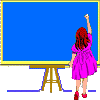
|
|
|
|
|
|
|
|
|
|
|
|
|
|
|
|
|
|

Number, Algebra, Measures
has an appreciation of mathematical pattern and structure
has the ability to apply mathematical knowledge and skills to problem solving
is beginning to attempt mathematical tasks of increasing length and complexity
can select materials appropriate to a task and works methodically
records and presents findings systematically in a variety of forms
discusses tasks and ask questions using the appropriate language
is able to read, write and order numbers and understands place value
demonstrates a good knowledge of number bonds
understands the meaning of negative numbers
recognises and understands fractions and percentages
has a good understanding of decimal notation and can apply this to money and measurement
is able to interpret a calculator display and can approximate to a given number of decimal places
can make and test statements and predictions
is able to measure and draw angles accurately
is able to use imperial units and knows the metric equivalents
has a sound knowledge of area and volume
gives up too easily when faced with a difficulty
needs to look at different ways of solving problems
does not yet realise that there may be more than one way of solving a problem
experiences difficulty in seeing number patterns
must check work thoroughly as is prone to careless errors
must learn tables thoroughly
does not have a sound enough knowledge of place value
relies too heavily on calculator
is not making enough use of estimation and approximation in determining a rough answer
lacks confidence when approaching new concepts and must ask for help when necessary
Shape, Space, Data Handling
has a positive attitude to mathematics and displays good spatial skills
shows independence in thinking and in methods used
has enjoyed a wide variety of mathematical activities both in and beyond the classroom
has gained a deeper understanding of mathematics through enquiry and practical activity
shows a keen interest in practical work and performs well both individually and as a member of a group
is able to use technical language when discussing the solution to a problem
plans work methodically and records findings systematically
has shown an interest in the construction of 3-D shapes using a range of materials
is able to recognise and describe two and three dimensional shapes and objects
is able to sort shapes in different ways and provide reasons for sorting
is able to understand and use language relating to angles
shows an understanding of probability
can construct and interpret charts, graphs and diagrams accurately
collects, records and processes data competently
is showing an increasing confidence in the collection and analysis of data
is able to enter and access information in simple data bases
needs to be more accurate when measuring
estimates are often wildly inaccurate
does not fully understand units of measurement and confuses centimetres and metres
does not fully understand probability, often confusing such things as 'unlikely' and 'impossible'
needs to plan work more carefully
finds new concepts difficult and rarely asks for help
must be more willing to explore and discuss alternative solutions to problems
needs to develop the confidence to ask and answer questions more readily
needs to concentrate on improving data handling skills, particularly when processing information